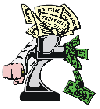INFORMATION ARTICLE

 |
Increasing Your Yield (by John D. Behle) |
||||||||||||||||||||||||||||||||||||||||||||||||||||||||||||
|
"Paper" has the unique advantage of having
two different values. There is a retail value or the
"face value" and there is wholesale value or
"present value." When a note is sold for cash, it
sells at a discount. This discounted price is the present
value and is determined by the rate of return or
"yield" that note buyers are looking for at that
time. This yield generally ranges from 20-28 percent and in
calculations in this article I'll use 24 percent. Terms
of the note
An example of this would be a note with a balance or
"face value" of $10,000 that sells at a price of
$6,000 which would be a 40 percent discount from the face
value. The amount of discount depends on the terms of the
note. Short-term notes require a small amount of discount,
while long-term notes require a larger discount.
Let's look at an example of two notes, one short-term and
one long-term and compare the amount of discount needed to
achieve a 24 percent yield.
Here is the first note and its terms:
$10,000 @ 11% = $217.42 per month for
60 months
Discounted to a 24 percent yield this note would be
worth $7,557.86. As you can see, the discount on this
note would be just under 25 percent.
Now, here are the terms of the second note:
$10,000 @ 11% = $103.22 per month for 240
months
When discounted to a 24 percent yield, this note
would be worth $5,116.41 which would be a discount of
just under 49 percent from the face value.
The amount and interest rate on both notes were the same
but the first note was worth over $2,400 more because
it paid off in 5 years instead of the 20 years
that the second note would take. Get
Your Calculator
If you want to follow along with a financial calculator,
here are the figures. The interest rate of 11 percent shows as
a monthly rate of .92 percent and the 24 percent yield shows
as the monthly rate of 2 percent. The columns of N, %I, PMT,
PV and FV should correspond to the buttons on your financial
calculator.
The N stands for the number of payments, I stands for the
interest rate, PMT stands for payment, PV stands for present
value, FV stands for future value. In these calculations, the
FV key is not used.
Discounting a note can be as simple as substituting the
desired yield for the interest rate and then solving for the
present value. The calculator has the needed formulas built
into it and when given three figures, will solve for the
fourth.
The point of these calculations is to show how large a difference the term of the note makes in the present value. Wouldn't it be nice to be able to buy the second note in our example and change it into the first note? You would pay the price of the second note and receive the value of the first note. The
Long-Term note
Now we'll talk about a couple of the many ways to buy a
long-term note at a large discount and increase the value by
shortening the term. One way to shorten the term is to find a
way to raise the monthly payment.
This, as well as the other ways to increase your yield,
involve a win-win situation where both the person paying on
the note and the person receiving the payments benefit. Raise
the Payment
Some banks and financial institutions are getting people to
pay higher monthly payments just by showing them that their
loan will pay off sooner.
Here is the difference it would make if a person added an
extra $50 per month to his payment on the following
note. The first line shows the original note and the second
line shows how the extra $50 would affect the terms.
This would make the loan pay off in half the time. Due to this, financial institutions have been quite successful in enticing some people to raise their monthly payments. If this principle is applied to notes you are receiving payments on, you can increase the value and your yield. You can also increase the number of people who will raise their payments by offering to lower their interest rate. A
contradiction of terms
But how can you lower the interest rate and increase your
yield at the same time? It may seem contradictory to be
increasing the yield while lowering the interest rate, but the
increased yield is accomplished by receiving the discount back
sooner. You'll see how it works as you follow along with the
calculations.
Look at the chart below. The first line shows the original
note and the second line shows what you would pay for the note
if it were bought at a 24 percent yield.
The person paying on the note has agreed to raise his payment by $100 in exchange for his interest rate being lowered from 10 percent to 6 percent. This will shorten the term of the note from 180 months to 55 months.
This will increase the value of the note, because the discount is coming back quicker. If you put 2 percent into the I column (24 percent yield divided by 12 for a monthly figure of 2 percent) and then solve for the present value, you'll see how much it has increased. This restructuring of the terms has raised the value of the note by almost $1,700. Since only $5,220.91 was paid, the rate of return or yield has increased to almost 40 percent (3.32 percent per month).
Once the note is restructured, you could sell it at a profit or borrow against it and use the funds to buy more notes and use the same process. Refinance
the Underlying loan
Another excellent way to increase your yield is to decrease
the cash flow on underlying financing. On wrap around loans
there is a payment coming in and one or several payments going
out. The difference between the payments is the cash flow that
the yield is calculated by. In lowering the amount going
towards underlying loans, the cash flow and the yield can be
increased. Many times there will be high interest rates and/or
short amortizations (a short term on the loan) which will
cause the payment to be needlessly high.
A common situation is a high interest rate on the second
loan and the cash flow on the wrap is almost non-existent for
several years until the second loan pays off. Some of these
notes even have a negative cash flow for the first few years
and are very difficult to sell. The person buying this type of
note requires a substantial discount because the cash flow is
so low that the "present value" of the note may be
35-50 percent of its face value. An
Example
Harry sold his property to Jim for $70,000 with a $l5,000
down payment. The amount of the "wrap" then was $55,000.
Harry received a payment from Jim and then had to make a
payment on two underlying loans--a first loan of $25,000
and a second loan of $l5,000.
Here are the terms on the wrap:
$55,000 at 12 percent payable, $579.27
per month for 300 months.
Now here are the terms on the first loan:
$25,000 at 9 percent payable, $209.80
per month for 300 months.
And here are the terms on the second loan:
$l5,000 at 21 percent payable, $342.18
per month for 84 months.
Harry's equity in the contract is the difference between
the $55,000 contract and the first and second loans
which total $40,000. His equity then is $l5,000.
Harry's monthly payment is the difference between the $579.27
per month coming in and the total payment of the first and
second loans ($551.98). This monthly cash flow would be
$27.29, but would increase to $369.47 per month
when the second loan is paid off. Looking
for a Buyer
Harry is looking around to sell his note and finds most
buyers aren't interested. Finally he finds Mr. Legree who
offers Harry $5,147.30 which would be a 24
percent yield. Mr. Legree purchases the note and immediately
finds a way to improve it. He refinances the second loan at 17
percent interest over 180 months. The new payment will
be $230.85. This increases the cash flow on Mr.
Legree's equity to $138.62 for 180 months and
then it will increase to $369.47.
This step that Mr. Legree has taken will increase his yield
from 24 percent to 33 percent and will increase
the value of his note from $5,147.30 to $7,399.86.
That is an increase of over $2,300 and that isn't a bad
profit just for using a little creativity.
If all of these figures seem a little confusing, let's sum
it up in three simple steps.
STEP 1: Mr. Legree buys a note that is a wrap and
has a high interest rate with a short term on the second loan.
STEP 2: He refinances the second with a lower
interest rate and a longer term.
STEP 3: Mr. Legree reaps the rewards of his
ingenuity.
The point of all this is profits! Don't worry about the
math if it is new to you, it's very easy to learn. Hopefully,
you've seen a couple of the many exciting, profitable
techniques that can make real estate paper one of the most
profitable forms of investment to ever exist.
About the Author . . . John holds an National Council of Exchangors "Gold
Card" and an EMS designation. He is also listed in Who's
Who In Creative Real Estate. John Behle is the author of
several hundred articles published in national magazines and
newsletters and of several ground-breaking real estate paper
books, including: * The Paper Game Trilogy |
|||||||||||||||||||||||||||||||||||||||||||||||||||||||||||||
![]() To
Fax this article to someone else for free click on the
box.
To
Fax this article to someone else for free click on the
box.
Home
Free Articles